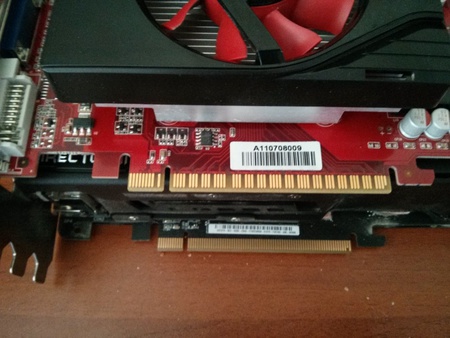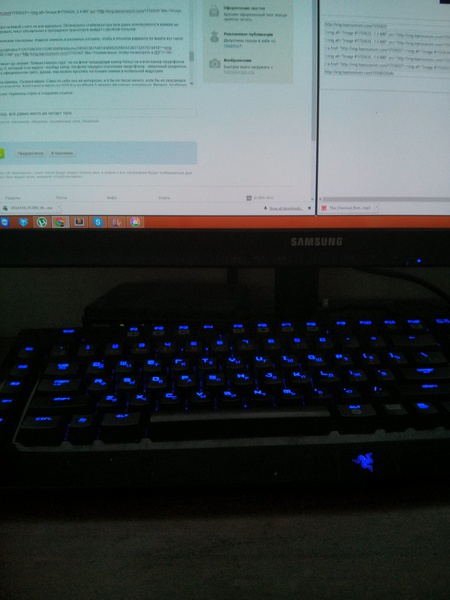LG Nexus 4 - personal experience and no translations
This is not the first material on Nexus 4, but I really wanted to share thoughts. I’ve been sitting on Android for a long time, and during that time I tried about a dozen different devices. I had both “Samsung” and “EychTiSi”, many friends have all sorts of “Sony” in large quantities. Naturally, one way or another, I had many of them in my hands on a flashing or just in my hands. LG devices caused me twofold feelings. At one time, there was practically no Optimus One p500 among state employees, and some devices were priced at a very decent level, but ... the software was not so smooth with software, updates, camera and some other functions. There is at least one LG, which has 100% no problems with updates and software. Here he is:

With the global transition to the production of devices on Android 4.0 and above, LG has more or less corrected: a new line of L-devices has acquired an intelligible shell (which can be called intuitive and understandable), pleasant prices, body materials, current stuffing and batteries ... (by the way, not so long ago, the first generation of the L-series received 4.1; not 4.2.x, but better than the complete lack of updates, and I don’t remember bonuses from 4.2 for state employees), but from the very beginning there was not a single flagship device.
After some time, they showed Optimus 4X HD - a device on a game (and I'm not a fan of a game), a 2X model changer. It was difficult to call it a flagship - neither the camera, nor the battery, nor the case made it outstanding, and at that moment the HTC One X, built on the same third game, was already on the market for a long time, and the flagship of another South Korean company, Galaxy S III, which tore competitors to shreds by camera, indicators of autonomy, screen, speed of work and aggressive work of the marketing department.
')
Galaxy competitors predicted devices on the new generation of Quallcomms - S4 Pro, with the four-core Krait architecture with the Adreno 320 video accelerator, only for a long time they were not visible - Sony used the S3 platform and Adreno 220/225 all year long, HTC created terrible cadavors in the middle segment, finally entangling users in their product line among a mountain of similar Desires and One's, LG released the marvelous Optimus Vu (and Vu 2), who tried to fight the Galaxy Note in the field of “plafonds”, but was inferior to it in functionality and some features of the software ... And here Optimus G comes onto the scene - what everyone was waiting for ... The benchmark results delight fans of computing power and amateurs to face off ... megahertz, high resolution camera and (for some time!) normal frame quality, nice body, screen ... In general, the device stuffed with fame.
Following him came the new flagship device from Google. Yes, at first there were problems with deliveries, but this has already been discussed a hundred times on the pages of Habrahabr, so let's not talk about sad things, now everything is OK, and the Nexus has been officially sold in Russia for a couple of months, if not for such a humane price. as in the states. Yes, the G Pro is already across the ocean, and only the first generation of Optimus G has just reached us ...
Nexus 4 I have about the new year. Why decided to write now? There was a clear feeling that I climbed into every corner of the phone, I know his abilities very well and in general, the materials on Nexus 4 were on Habré, but for the most part these were either announcements or information on sales resumption or translations of foreign materials.
So, the nexus. Four cores, two gigabytes of RAM, sixteen gigabytes of internal memory, an eight megapixel camera and a nearly five-inch display with a resolution of 1280x768. Is it a lot or a little? How relevant are its features? At the time of the announcement and the start of sales, the device was the most natural flagship. The most current version of hardware and OSes. Now comes the “new” generation of flagship Android-devices (five-inch FullHD shovels), but their differences from the current one are minimal - regular megapixels and megahertz, there is no such qualitative jerk as the past and before last generations of flagship devices (mass transition to dual-core solutions in 2011 year and the transition to HD-resolution in 2012), so that the Nexus can still be called a top device, and require the most decent results from it. Yes, and the Nexus 5 is not yet sold :)
Technical reviews, tests and tests on the Internet are already a thousand and one, and they all say the same thing: one of the fastest devices at the time of release. And, since there are already a lot of similar texts, my review will rather be an attempt to share experiences and sensations from switching to a Nexus device with a wide experience of owning non-Nexus devices on the Android OS.
I got the smartphone, as it is now fashionable, in a box that slightly exceeds the device and its configuration in size. The trendsetter is, of course, the iPhone, and time has played its part. Earlier, the purchase of a mobile phone was, if not an event, then at least a “big” and impressive purchase, and the boxes were made to match:
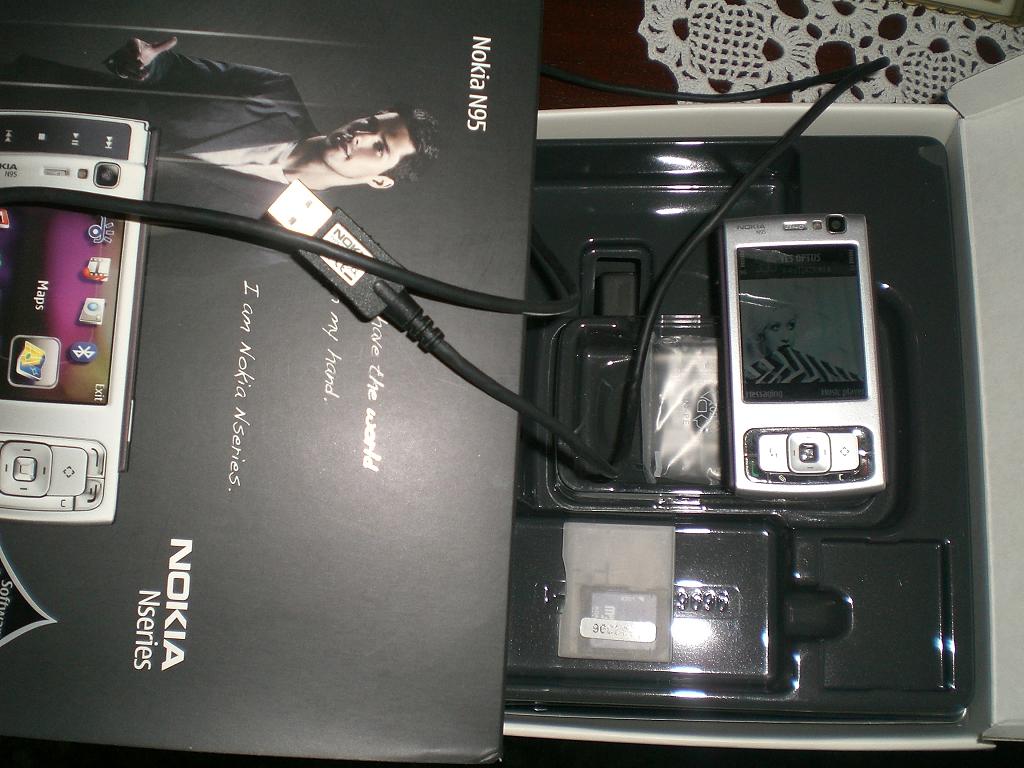
Now the mobile phone is cheaper than an IKEA chair, and we already see smartphones almost more often than regular dumb-phones, so the packaging has ceased to be a “holiday”. Inside is the device itself, under the substrate - charging (very compact and neat), USB-Micro USB cable, instructions for the device. Frankly, I miss the days of "rich bundling", with two batteries, a docking station, a headset, multi-volume literature-waste paper (sometimes even color!), Interchangeable panels, and so on.
The device on both sides is covered with a protective film, which, if desired, will last a week or two, if you are a fan of remotes in sachets. I - no, so the film was instantly removed and ejected. Under it is a protective glass of the front and rear surfaces (yes, the back of the smartphone is also covered with glass, and may fall if it falls). The specifications claim that second-generation Gorilla Glass is used. Check this fact is not very desirable, so it remains to believe in the word. At least for all the time of operation, not a single scratch appeared on the glass. The front panel differs from the previous Nexus, whose glass was slightly “concave” - this time the main planes of the smartphone are parallel and do not contain bends, but the left and right edges are neatly “bent”, which is clearly seen in the photo:

Due to this bending, the device lies better in the hand, does not cut the sharp edge into the palm of the hand, makes it easy to swipe from the edge of the screen and generally looks unusual. Of all the Android devices that I had, only the S III had a similar edge, although its glass was “smoothed out” under a different radius and around the entire perimeter. Nexus screen is framed by a silver frame. The coating is a thin layer of metallization on a plastic base. Perhaps the most unfortunate part from the point of view of the constructive is to quickly scratch and lose its original appearance. The side faces are made of black soft-touch plastic, pleasant to the touch and does not collect dirt and dust.

On the left side of the smartphone - the volume swing (and the tray under the SIM card), on the right - the lock / shutdown button. Other hardware or touch keys are not provided. The buttons themselves are quite tight and take several days to get used to, especially if you had a device with long buttons, such as the Galaxy S III / Galaxy Nexus.
The back surface is also covered with glass, but its edges are hidden under soft-touch plastic, I think it will live this way longer, and this technique solves another problem. The fact is that both glasses are covered with oleophobic coating and perfectly polished - if the smartphone is put on the surface with a slight incline, then it will crawl on it. So the convenient soft-touch frame serves as a kind of brake that holds the device on smooth surfaces. The back panel pattern, in my opinion, is a great solution. Looks nice and plays nicely in the sun. All the friends that saw this device in my hands asked what it was, I showed them the back of the smartphone, with the inscription "nexus" and answered: "new nexus". Well, in return I received compliments on the design of the back panel of the device ...
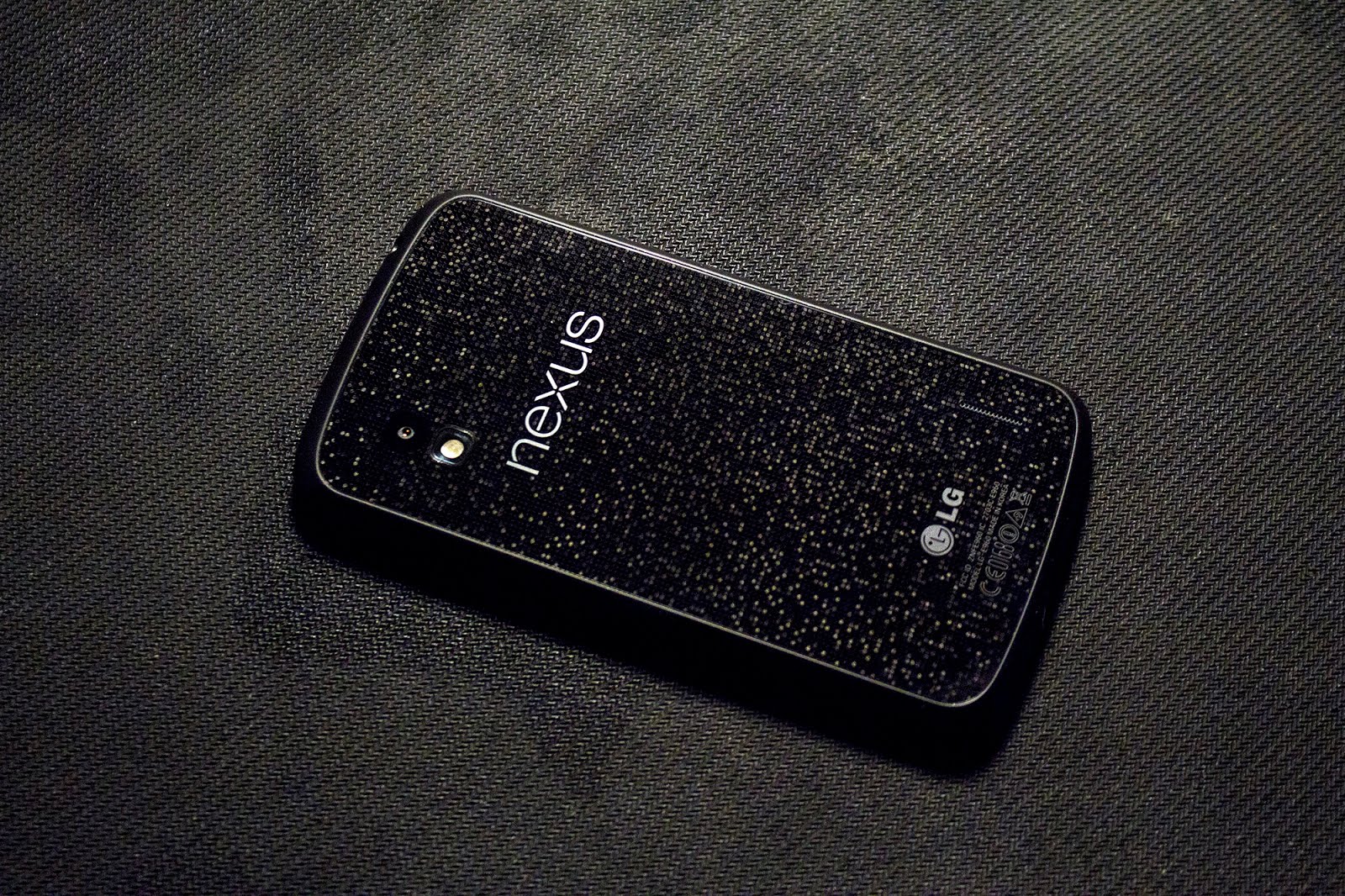
And then I removed my palm from the LG logo, and watched how the person “breaks the pattern”.

After, to put it mildly, not the most successful cases of the solutions of 2011 - the beginning of 2012 and the faceless style of the L-line of smartphones (no, they, of course, were good for their price range, but these are state employees), LG produces excellent, I would even say “Expensive” design, devoid of debris and dirt in the lines: simple shapes, simple bends, simple but very pleasant materials, monolithic assembly, no protruding parts like a camera, flash, buttons or speaker grids. Neat, concise, finished appearance, the eye is happy and nice to hold in your hand. It is good that in South Korea they finally stopped copying the design of gadgets, and began to develop themselves, and they cope with this well.
Oleophobic coating of glass surfaces, by the way, is of excellent quality - there are fewer prints on the screen and the back panel than on the third galaxy or iPhone, and they are easier to remove. I could not photograph them in any sane form.
Display
The screen is IPS, 4.7 inches, 1280x768. The color rendition and brightness margin are excellent, the contrast is at the level of modern smartphones. In the sun, the screen significantly fades, but the text remains readable, and the auto brightness of the screen instantly adjusts the backlight to the maximum. Sms read, google, climb, make a photo - that's enough.

Yes, black, of course, is not AMOLED'ovo black, but does not cause irritation with "gray" or "dark violet" in the dark. I wonder when they will learn how to make controlled backlight matrices on white OLEDs in order to combine the advantages of IPS and AMOLED matrices?
With viewing angles, everything is very good: LG didn’t stint and set up a really cool screen, all the parameters of which correspond to the expectations of users buying a device that bears the proud name of the flagship of the current Google-smartphone-fleet.
However, the photo here will say a lot more than the words:
The device consists not only of a beautiful case and a high-quality display, and behind the touch screen there is a fiery heart hidden, which can be called the most powerful mobile chip in its generation. The central processor was developed by Quallcomm, has four cores built according to the Krait architecture (it cannot be called ARM v7 Cortex A9, but it did not grow to A15, although it is close to it). Similar quad-core solutions from Samsung, Ti OMAP, and ARM reference solutions (on the Cortex A9 architecture) lose a little performance, if we compare them with benchmarks and number of crushers, but all the flagships of 2012 show excellent results in real life: computing power is enough, and synthetic performance Krait's four-core solution can be called redundant. Although, frankly, I did not see a single user who would refuse a powerful piece of hardware, and it’s hard to believe that the phone would have worked longer on a similar dual-core processor. In addition, the more powerful the hardware, the longer Google will be able to support Nexus 4 and distribute the latest OS versions to it.
One of the best solutions at the time of release - Adreno 320 is also responsible for the graphics. In the list of supported technologies, perhaps, all modern chips: OpenGL ES 3.0 1 , 2.0 & 1.1, OpenCL 1.2, OpenVG 1.1, EGL 1.4, plus Direct3D 9.3 (desktop capabilities graphics cards generation Nvidia 6000, Ati x1900), SVGT 1.2, Direct Draw and GDI.
All benchmarks show excellent results, in all tested games FPS does not sag even in the most complex and dynamic scenes, and compatibility with existing and emerging games is excellent. With the help of the ChainFire utility, you can get all the special effects that are available on Nvidia Tegra GPUs (if a lazy or biased developer did not bother to tie them to the Adreno-cache of the game), and the performance of the games will not change a jot. Now games on mobile phones are very close to the graphics on consoles, and the ported GTA 3 / Vice City already look faded and cause rather nostalgic feelings than admiration for the possibilities.
Here are screenshots of modern mobile toys:
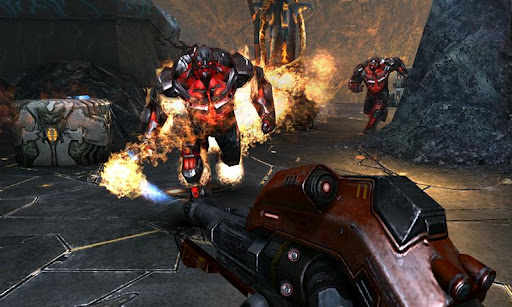


But the ported games of the early 2000s:




Well, here is the test run of NFS MostWanted 2012. Gameplay - from 0:40, anchor in the link for some reason is not put: (
Wireless interfaces include the standard set of 2012: Bluetooth 4.0 with support for A2DP stereo sound and EDR, NFC, 2G (850/900/1800/1900) and 3G (850/900/1700/1900/2100), Wi-Fi 802.11 b / g / n. By itself, tehtering is supported. LTE is, but hidden in the engineering menu and not sure what will work with our frequencies. Here, nothing special, the quality is excellent, the device confidently catches the network and WiFi, and holds the signal tenaciously. Where the iPhone is rented, and switches from WiFi to 3G, and the Meizu MX2 does not see the operator’s network, Nexus confidently uses WiFi and holds the network, even if it’s for “two sticks”.
For navigation capabilities meets GPS chip gpsOneGen 8A with Glonass support.
I have no complaints about wireless interfaces, and nothing interesting here can be written. The phone receives a signal, it can call, the voice transmits clearly and loudly enough, noise, if possible, cuts. What else does? Screenshot with Wi-Fi signal strength test? I don’t think anyone is very interested. There are no super-antennas declared in the device, so we will not see anything supernatural.
The smartphone has two cameras, useless, at 1.3 megapixels, and the back one (that is, the main one), at 8. It's funny, but the flash and not the “lens” received a separate frame and a mini glass window.

I think this is done so that the flash does not illuminate the glass of the rear panel and does not interfere with the camera module shooting. And I would not say that photography is the fad of this device, it shoots at the level of smartphones in 2012, but the interface of the camera application is the best, in my opinion, in the mobile industry. Here are some photos in different conditions:
During the day the camera tries to keep the minimum ISO (100-200), to shoot at shutter speeds from 1/1500 to 1/100. Evening or night shots are obtained at shutter speeds of 1 / 60-1 / 20, ISO takes off to 1600 and above. There are not so many noises (for the camera of a mobile device), against the background of past Nexus - progress on the face.But the picture quality leaves much to be desired: the algorithms for obtaining information from the matrix aggressively devour the details and produce artifacts.
HDR mode is supported, and it is honestly glued from three frames, and not pulled from one RAW, as on some devices. Here is a proof from dynamic scenes (without HDR, with HDR, and a glitch when recorded under changing light):
The camera does not work perfectly, but sometimes you get good shots. The main problem is the shooting speed, for 2012 it is so-so. Autofocus - tenacious, perfectly removes the macro, but in the dark for a long time catches a contrasting object to start work. An optical stabilizer (or even an electronic analogue) in the camera is not provided; take a picture of the ad text in a shaking vehicle will be released from the tenth attempt.
Spherical panoramas are perfectly implemented, the main thing is to shoot in reasonable conditions, so that in a flat version this does not work out:

As you can see, the photographic abilities of the smartphone do not allow him to fight for the title of “Best Mobile Camera of the Year”, but against the background of previous Nexus cameras and all LG 2012 smartphones cameras that I have seen - generally super. If you compare with the current generation of smartphones - surely average, but considering the price of Nexus on the official website, I think it can be forgiven for not the best pictures in the mobile industry.
But there is another type of camera work. Shooting video. It is not interesting in itself (due to the lack of any outstanding results in this field over the past year), and I would not have written anything if it were not for the terrifying sound quality when shooting at a concert. Similar video on SGS III and iPhone 5 sounded absolutely normal. Apparently, the problem is software. Here is an example of a bug:
The quality of the picture is quite “smartphone” level. In conditions with the absence of extremely loud sound sources, everything is OK.
To write about Nexus and not write about his OS would be a crime. Perhaps the entire Nexus program is first and foremost an example of pure Android with the taste of Google, and secondly, everything else. The most current software versions, the fastest update, and the longest official support are Nexus. The device comes with the operating system Android 4.2 Jelly Bean, and be sure to get the update to Key Lime Pie one of the first (if not the first). From Samsung, LG and any other HTC with Sony Nexus OS, the interface has a clean interface, at least Vendor garbage and pseudo technologies, an abundance of free memory in the device (which is not so much: Nexus memory cards are not provided again that upsets me), the simplicity and functionality of the basic Google applications.After you turn on the device and enter the WiFi keys to it, most likely, you will immediately receive a message that there are updates for it. About the features of Android 4.2 wrote everywhere, to bring the same information here does not see the point. Better to write about the impressions.
Previously, the new smartphone was used as? For several days (weeks) I went with the stock firmware, trying to put up with some of its flaws. Then he ruled (if ruthlessly), and demolished a bunch of vendor stuff. I went for another week or two, occasionally bumping into uncomfortable moments in the official ROM. After that, the installation of Android AOKP with a small number of tweaks followed, and the smartphone remained in this state, occasionally receiving OTA updates from the creator of the firmware.
Nexus 4 is still not ruled by me. I do not see the point. There is simply nothing superfluous in the phone that I would like to remove, and there is nothing that I would like to fix by installing a third-party ROM. Hopefully, Google will click on the manufacturers, and make them come to their senses. It is impossible to turn a clean, neat, perfectly working system into such a hotbed as we can see with the same Samsung. Compare yourself, the Cyanogen-based firmware for the third galaxy is from 80 to 150 megabytes, depending on the mincemeat. Samsung firmware - 800-900 megabytes. What could be stuffed there in such a volume? Yes, of course, the S III works better with the camera on the drain and there is a two-pane mode (it seems that LG also has something similar in new smartphones. Not yet encountered). But on this bonuses come to an end. It's hard to believe,that such improvements require 700 megabytes of additional software.
Perfectly working Google Now, excellent Google Currents application, convenient built-in software. UI on guidelines. In general, I am now an adept of the Nexus approach to Android. A minimum of superfluous, maximum opportunities.
Nexus 4 is inexpensive (especially if ordered from the USA and delivered through ShopFans), a powerful, beautiful smartphone, which still has a minimum of drawbacks with a large number of advantages.
My vision of Nexus (and especially its eight-version version) is a working smartphone. If you use it as a workhorse, then it will not have gigabytes of music and video, 500 photos “we are on the beach”, photos of scraps in instagram and other “home” environments, but there will be an excellent stock keyboard and browser, almost perfect work with several email boxes, messenger, camera, to take a picture of a document / business card, an excellent screen with a very accurate touch-sensor, which allows you to edit incoming documents via Google Drive or any mobile office on the fly. In general, the whole juz-case, which does not imply the storage on the phone of a large amount of “heavy” content. On the road, you can always throw yourself a movie or a few, some music or books, the smartphone will perfectly cope with any load, with any toy and with any application,and its strict and honest appearance gives the impression of an expensive device.
1 — OpenGL ES 3.0 : Mairon , 3.0 Adreno 320 HF, SoC Qualcomm Snapdragon 600.

With the global transition to the production of devices on Android 4.0 and above, LG has more or less corrected: a new line of L-devices has acquired an intelligible shell (which can be called intuitive and understandable), pleasant prices, body materials, current stuffing and batteries ... (by the way, not so long ago, the first generation of the L-series received 4.1; not 4.2.x, but better than the complete lack of updates, and I don’t remember bonuses from 4.2 for state employees), but from the very beginning there was not a single flagship device.
After some time, they showed Optimus 4X HD - a device on a game (and I'm not a fan of a game), a 2X model changer. It was difficult to call it a flagship - neither the camera, nor the battery, nor the case made it outstanding, and at that moment the HTC One X, built on the same third game, was already on the market for a long time, and the flagship of another South Korean company, Galaxy S III, which tore competitors to shreds by camera, indicators of autonomy, screen, speed of work and aggressive work of the marketing department.
')
Galaxy competitors predicted devices on the new generation of Quallcomms - S4 Pro, with the four-core Krait architecture with the Adreno 320 video accelerator, only for a long time they were not visible - Sony used the S3 platform and Adreno 220/225 all year long, HTC created terrible cadavors in the middle segment, finally entangling users in their product line among a mountain of similar Desires and One's, LG released the marvelous Optimus Vu (and Vu 2), who tried to fight the Galaxy Note in the field of “plafonds”, but was inferior to it in functionality and some features of the software ... And here Optimus G comes onto the scene - what everyone was waiting for ... The benchmark results delight fans of computing power and amateurs to face off ... megahertz, high resolution camera and (for some time!) normal frame quality, nice body, screen ... In general, the device stuffed with fame.
Following him came the new flagship device from Google. Yes, at first there were problems with deliveries, but this has already been discussed a hundred times on the pages of Habrahabr, so let's not talk about sad things, now everything is OK, and the Nexus has been officially sold in Russia for a couple of months, if not for such a humane price. as in the states. Yes, the G Pro is already across the ocean, and only the first generation of Optimus G has just reached us ...
Nexus 4 I have about the new year. Why decided to write now? There was a clear feeling that I climbed into every corner of the phone, I know his abilities very well and in general, the materials on Nexus 4 were on Habré, but for the most part these were either announcements or information on sales resumption or translations of foreign materials.
So, the nexus. Four cores, two gigabytes of RAM, sixteen gigabytes of internal memory, an eight megapixel camera and a nearly five-inch display with a resolution of 1280x768. Is it a lot or a little? How relevant are its features? At the time of the announcement and the start of sales, the device was the most natural flagship. The most current version of hardware and OSes. Now comes the “new” generation of flagship Android-devices (five-inch FullHD shovels), but their differences from the current one are minimal - regular megapixels and megahertz, there is no such qualitative jerk as the past and before last generations of flagship devices (mass transition to dual-core solutions in 2011 year and the transition to HD-resolution in 2012), so that the Nexus can still be called a top device, and require the most decent results from it. Yes, and the Nexus 5 is not yet sold :)
Technical reviews, tests and tests on the Internet are already a thousand and one, and they all say the same thing: one of the fastest devices at the time of release. And, since there are already a lot of similar texts, my review will rather be an attempt to share experiences and sensations from switching to a Nexus device with a wide experience of owning non-Nexus devices on the Android OS.
What did Google have before Nexus4?
Hidden text
The first Google smartphone was the HTC Dream, also known as Android Dev Alpha.
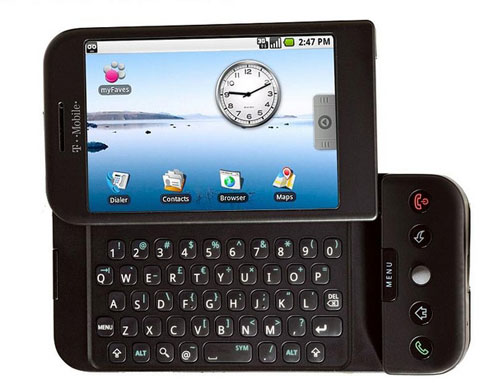
Supplied with Android OS version 1.6, it had limitations on access to the paid part of the Android Market (in the case of Dev Alpha), and its performance characteristics were difficult to say impressive: single-core ARM 11 Qualcomm MSM7201A processor with a clock frequency of 553 MHz, 192 megabytes of RAM, 256 megabytes of internal memory, support for microSDHC cards, a screen with a resolution of 320x480, displaying 65535 colors. All the iron fed the battery capacity of 1100 mAh.
The horizontal slider quickly found its audience and won the hearts of geeks: during the period when the model was on sale, more than 1 million devices were sold. Not bad for the first mover of the new OS?
He was replaced by HTC Desire, also known as Google Nexus One, as the main Google device.
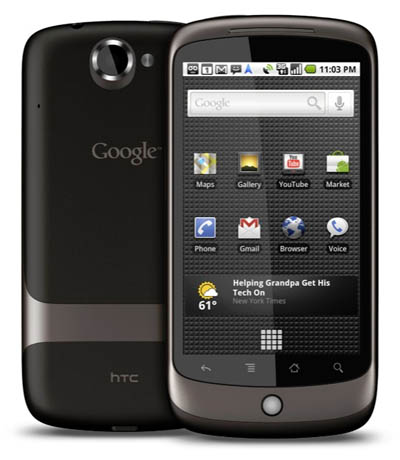
Gigahertz ARM V7 processor, 512 MB of RAM, excellent Amoled-display with a resolution of 800x480 pixels, trackball, and most importantly - Andoid 2.1 (updated to 2.3.7) became the key to success of the new Google-flagship. Fast, reliable, convenient and very popular, he made Android a really strong player in the market, and raised the bar for manufactured devices. In many ways, thanks to him (as well as his almost complete hardware compatibility with HTC HD2), Android was launched on the WinMo HD2 device. Some still use it (or HD2) and do not know grief, though a dying battery and a small amount of RAM sooner or later will force them to move to something modern.
After almost a year, it was replaced by the Nexus S - this time the Google flagship was produced by Samsung, the first to receive Android version 2.3.6, and became the first smartphone in the world using NFC technology.

Curved glass of the touchscreen has become its main feature. Unusual shape, current stuffing, quite good case materials, 16 gigabytes of internal memory (there was no slot for a MicroSD card, but 16 gigabytes at the turn of 2010-2011 was an ample memory) made the device popular. Subsequently, the Nexus S was updated to Android 4.0 and 4.1.2. At the moment, official support is complete.
A replacement for the Nexus S was the Galaxy Nexus. It is not difficult to guess by name who became the manufacturer of this device. In this “iteration”, Google decided to abandon the physical buttons (albeit in a touch version), and transferred them inside the operating system, in the form of a navibar.
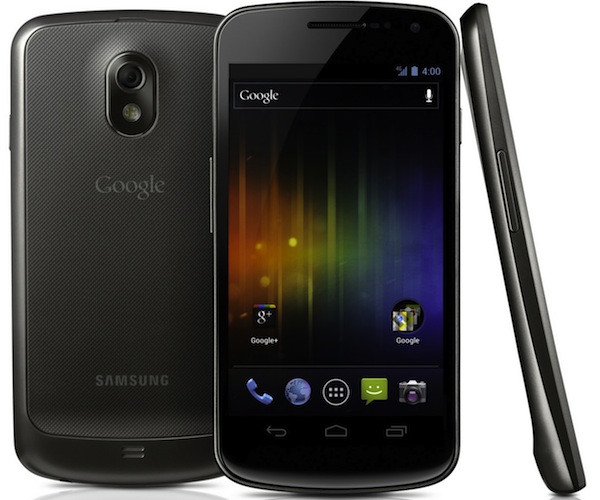
Galaxy Nexus was equipped with a huge (at the time of release) 4.65-inch screen with HD-resolution, 16 gigabytes of memory, a 1.2 GHz dual-core processor and a gigabyte of RAM. The Galaxy Nexus became the first device to receive Android 4.0 (and upgrade to 4.1, now running 4.2), and in many ways became the prototype for the late Galaxy S III, which successfully fought for the European and Asian market throughout the year.
Well, his changer was the Nexus 4, which I wanted to talk about today.
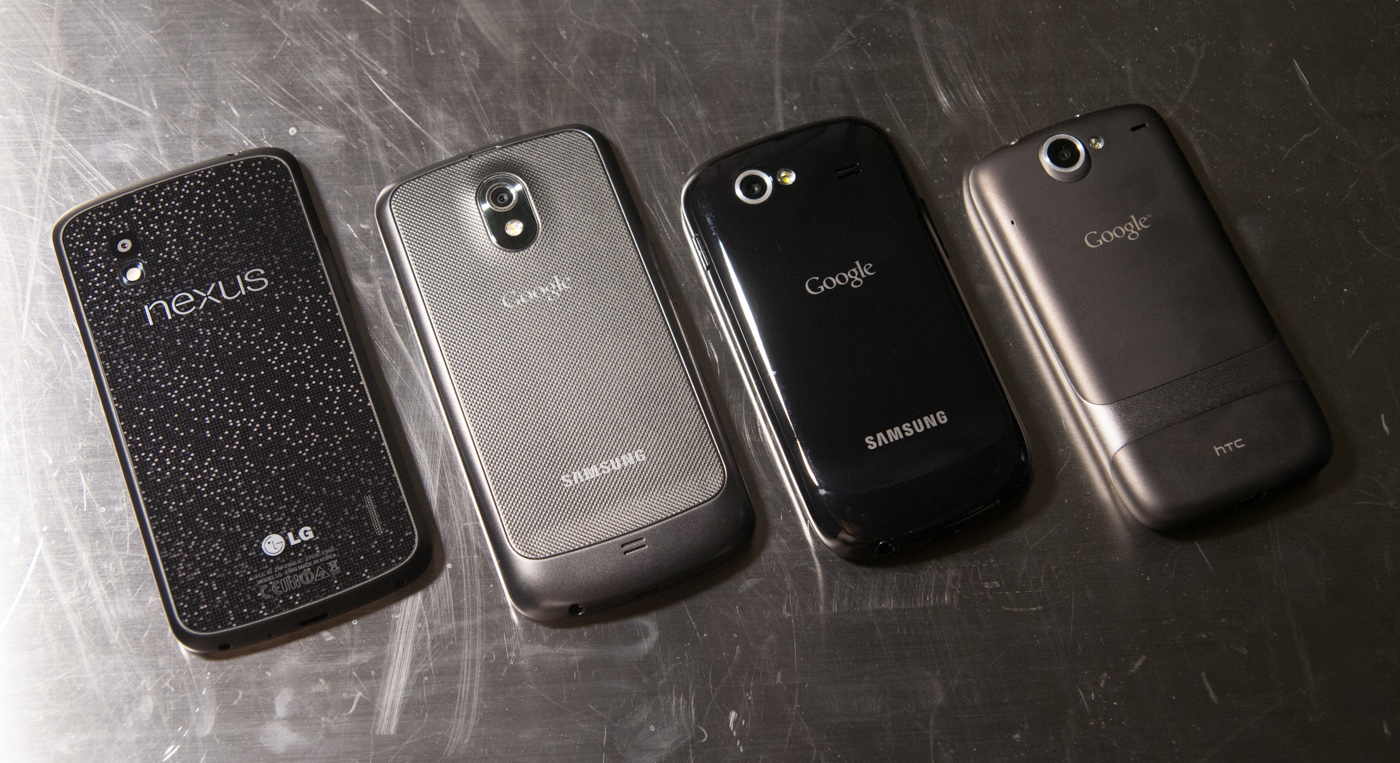

Supplied with Android OS version 1.6, it had limitations on access to the paid part of the Android Market (in the case of Dev Alpha), and its performance characteristics were difficult to say impressive: single-core ARM 11 Qualcomm MSM7201A processor with a clock frequency of 553 MHz, 192 megabytes of RAM, 256 megabytes of internal memory, support for microSDHC cards, a screen with a resolution of 320x480, displaying 65535 colors. All the iron fed the battery capacity of 1100 mAh.
The horizontal slider quickly found its audience and won the hearts of geeks: during the period when the model was on sale, more than 1 million devices were sold. Not bad for the first mover of the new OS?
He was replaced by HTC Desire, also known as Google Nexus One, as the main Google device.

Gigahertz ARM V7 processor, 512 MB of RAM, excellent Amoled-display with a resolution of 800x480 pixels, trackball, and most importantly - Andoid 2.1 (updated to 2.3.7) became the key to success of the new Google-flagship. Fast, reliable, convenient and very popular, he made Android a really strong player in the market, and raised the bar for manufactured devices. In many ways, thanks to him (as well as his almost complete hardware compatibility with HTC HD2), Android was launched on the WinMo HD2 device. Some still use it (or HD2) and do not know grief, though a dying battery and a small amount of RAM sooner or later will force them to move to something modern.
After almost a year, it was replaced by the Nexus S - this time the Google flagship was produced by Samsung, the first to receive Android version 2.3.6, and became the first smartphone in the world using NFC technology.

Curved glass of the touchscreen has become its main feature. Unusual shape, current stuffing, quite good case materials, 16 gigabytes of internal memory (there was no slot for a MicroSD card, but 16 gigabytes at the turn of 2010-2011 was an ample memory) made the device popular. Subsequently, the Nexus S was updated to Android 4.0 and 4.1.2. At the moment, official support is complete.
A replacement for the Nexus S was the Galaxy Nexus. It is not difficult to guess by name who became the manufacturer of this device. In this “iteration”, Google decided to abandon the physical buttons (albeit in a touch version), and transferred them inside the operating system, in the form of a navibar.

Galaxy Nexus was equipped with a huge (at the time of release) 4.65-inch screen with HD-resolution, 16 gigabytes of memory, a 1.2 GHz dual-core processor and a gigabyte of RAM. The Galaxy Nexus became the first device to receive Android 4.0 (and upgrade to 4.1, now running 4.2), and in many ways became the prototype for the late Galaxy S III, which successfully fought for the European and Asian market throughout the year.
Well, his changer was the Nexus 4, which I wanted to talk about today.

First impressions
I got the smartphone, as it is now fashionable, in a box that slightly exceeds the device and its configuration in size. The trendsetter is, of course, the iPhone, and time has played its part. Earlier, the purchase of a mobile phone was, if not an event, then at least a “big” and impressive purchase, and the boxes were made to match:

Now the mobile phone is cheaper than an IKEA chair, and we already see smartphones almost more often than regular dumb-phones, so the packaging has ceased to be a “holiday”. Inside is the device itself, under the substrate - charging (very compact and neat), USB-Micro USB cable, instructions for the device. Frankly, I miss the days of "rich bundling", with two batteries, a docking station, a headset, multi-volume literature-waste paper (sometimes even color!), Interchangeable panels, and so on.
Design and appearance
The device on both sides is covered with a protective film, which, if desired, will last a week or two, if you are a fan of remotes in sachets. I - no, so the film was instantly removed and ejected. Under it is a protective glass of the front and rear surfaces (yes, the back of the smartphone is also covered with glass, and may fall if it falls). The specifications claim that second-generation Gorilla Glass is used. Check this fact is not very desirable, so it remains to believe in the word. At least for all the time of operation, not a single scratch appeared on the glass. The front panel differs from the previous Nexus, whose glass was slightly “concave” - this time the main planes of the smartphone are parallel and do not contain bends, but the left and right edges are neatly “bent”, which is clearly seen in the photo:

Due to this bending, the device lies better in the hand, does not cut the sharp edge into the palm of the hand, makes it easy to swipe from the edge of the screen and generally looks unusual. Of all the Android devices that I had, only the S III had a similar edge, although its glass was “smoothed out” under a different radius and around the entire perimeter. Nexus screen is framed by a silver frame. The coating is a thin layer of metallization on a plastic base. Perhaps the most unfortunate part from the point of view of the constructive is to quickly scratch and lose its original appearance. The side faces are made of black soft-touch plastic, pleasant to the touch and does not collect dirt and dust.

On the left side of the smartphone - the volume swing (and the tray under the SIM card), on the right - the lock / shutdown button. Other hardware or touch keys are not provided. The buttons themselves are quite tight and take several days to get used to, especially if you had a device with long buttons, such as the Galaxy S III / Galaxy Nexus.
The back surface is also covered with glass, but its edges are hidden under soft-touch plastic, I think it will live this way longer, and this technique solves another problem. The fact is that both glasses are covered with oleophobic coating and perfectly polished - if the smartphone is put on the surface with a slight incline, then it will crawl on it. So the convenient soft-touch frame serves as a kind of brake that holds the device on smooth surfaces. The back panel pattern, in my opinion, is a great solution. Looks nice and plays nicely in the sun. All the friends that saw this device in my hands asked what it was, I showed them the back of the smartphone, with the inscription "nexus" and answered: "new nexus". Well, in return I received compliments on the design of the back panel of the device ...

And then I removed my palm from the LG logo, and watched how the person “breaks the pattern”.

After, to put it mildly, not the most successful cases of the solutions of 2011 - the beginning of 2012 and the faceless style of the L-line of smartphones (no, they, of course, were good for their price range, but these are state employees), LG produces excellent, I would even say “Expensive” design, devoid of debris and dirt in the lines: simple shapes, simple bends, simple but very pleasant materials, monolithic assembly, no protruding parts like a camera, flash, buttons or speaker grids. Neat, concise, finished appearance, the eye is happy and nice to hold in your hand. It is good that in South Korea they finally stopped copying the design of gadgets, and began to develop themselves, and they cope with this well.
Oleophobic coating of glass surfaces, by the way, is of excellent quality - there are fewer prints on the screen and the back panel than on the third galaxy or iPhone, and they are easier to remove. I could not photograph them in any sane form.
Display
The screen is IPS, 4.7 inches, 1280x768. The color rendition and brightness margin are excellent, the contrast is at the level of modern smartphones. In the sun, the screen significantly fades, but the text remains readable, and the auto brightness of the screen instantly adjusts the backlight to the maximum. Sms read, google, climb, make a photo - that's enough.
Yes, black, of course, is not AMOLED'ovo black, but does not cause irritation with "gray" or "dark violet" in the dark. I wonder when they will learn how to make controlled backlight matrices on white OLEDs in order to combine the advantages of IPS and AMOLED matrices?
With viewing angles, everything is very good: LG didn’t stint and set up a really cool screen, all the parameters of which correspond to the expectations of users buying a device that bears the proud name of the flagship of the current Google-smartphone-fleet.
However, the photo here will say a lot more than the words:
Hidden text
Photo taken from the moody review of mobile-review.

Photo taken from the moody review of mobile-review.
Filling and Productivity
The device consists not only of a beautiful case and a high-quality display, and behind the touch screen there is a fiery heart hidden, which can be called the most powerful mobile chip in its generation. The central processor was developed by Quallcomm, has four cores built according to the Krait architecture (it cannot be called ARM v7 Cortex A9, but it did not grow to A15, although it is close to it). Similar quad-core solutions from Samsung, Ti OMAP, and ARM reference solutions (on the Cortex A9 architecture) lose a little performance, if we compare them with benchmarks and number of crushers, but all the flagships of 2012 show excellent results in real life: computing power is enough, and synthetic performance Krait's four-core solution can be called redundant. Although, frankly, I did not see a single user who would refuse a powerful piece of hardware, and it’s hard to believe that the phone would have worked longer on a similar dual-core processor. In addition, the more powerful the hardware, the longer Google will be able to support Nexus 4 and distribute the latest OS versions to it.
One of the best solutions at the time of release - Adreno 320 is also responsible for the graphics. In the list of supported technologies, perhaps, all modern chips: OpenGL ES 3.0 1 , 2.0 & 1.1, OpenCL 1.2, OpenVG 1.1, EGL 1.4, plus Direct3D 9.3 (desktop capabilities graphics cards generation Nvidia 6000, Ati x1900), SVGT 1.2, Direct Draw and GDI.
All benchmarks show excellent results, in all tested games FPS does not sag even in the most complex and dynamic scenes, and compatibility with existing and emerging games is excellent. With the help of the ChainFire utility, you can get all the special effects that are available on Nvidia Tegra GPUs (if a lazy or biased developer did not bother to tie them to the Adreno-cache of the game), and the performance of the games will not change a jot. Now games on mobile phones are very close to the graphics on consoles, and the ported GTA 3 / Vice City already look faded and cause rather nostalgic feelings than admiration for the possibilities.
Here are screenshots of modern mobile toys:



But the ported games of the early 2000s:




Well, here is the test run of NFS MostWanted 2012. Gameplay - from 0:40, anchor in the link for some reason is not put: (
Wireless interfaces
Wireless interfaces include the standard set of 2012: Bluetooth 4.0 with support for A2DP stereo sound and EDR, NFC, 2G (850/900/1800/1900) and 3G (850/900/1700/1900/2100), Wi-Fi 802.11 b / g / n. By itself, tehtering is supported. LTE is, but hidden in the engineering menu and not sure what will work with our frequencies. Here, nothing special, the quality is excellent, the device confidently catches the network and WiFi, and holds the signal tenaciously. Where the iPhone is rented, and switches from WiFi to 3G, and the Meizu MX2 does not see the operator’s network, Nexus confidently uses WiFi and holds the network, even if it’s for “two sticks”.
For navigation capabilities meets GPS chip gpsOneGen 8A with Glonass support.
I have no complaints about wireless interfaces, and nothing interesting here can be written. The phone receives a signal, it can call, the voice transmits clearly and loudly enough, noise, if possible, cuts. What else does? Screenshot with Wi-Fi signal strength test? I don’t think anyone is very interested. There are no super-antennas declared in the device, so we will not see anything supernatural.
Camera
The smartphone has two cameras, useless, at 1.3 megapixels, and the back one (that is, the main one), at 8. It's funny, but the flash and not the “lens” received a separate frame and a mini glass window.

I think this is done so that the flash does not illuminate the glass of the rear panel and does not interfere with the camera module shooting. And I would not say that photography is the fad of this device, it shoots at the level of smartphones in 2012, but the interface of the camera application is the best, in my opinion, in the mobile industry. Here are some photos in different conditions:
During the day the camera tries to keep the minimum ISO (100-200), to shoot at shutter speeds from 1/1500 to 1/100. Evening or night shots are obtained at shutter speeds of 1 / 60-1 / 20, ISO takes off to 1600 and above. There are not so many noises (for the camera of a mobile device), against the background of past Nexus - progress on the face.But the picture quality leaves much to be desired: the algorithms for obtaining information from the matrix aggressively devour the details and produce artifacts.
HDR mode is supported, and it is honestly glued from three frames, and not pulled from one RAW, as on some devices. Here is a proof from dynamic scenes (without HDR, with HDR, and a glitch when recorded under changing light):
The camera does not work perfectly, but sometimes you get good shots. The main problem is the shooting speed, for 2012 it is so-so. Autofocus - tenacious, perfectly removes the macro, but in the dark for a long time catches a contrasting object to start work. An optical stabilizer (or even an electronic analogue) in the camera is not provided; take a picture of the ad text in a shaking vehicle will be released from the tenth attempt.
Spherical panoramas are perfectly implemented, the main thing is to shoot in reasonable conditions, so that in a flat version this does not work out:

As you can see, the photographic abilities of the smartphone do not allow him to fight for the title of “Best Mobile Camera of the Year”, but against the background of previous Nexus cameras and all LG 2012 smartphones cameras that I have seen - generally super. If you compare with the current generation of smartphones - surely average, but considering the price of Nexus on the official website, I think it can be forgiven for not the best pictures in the mobile industry.
But there is another type of camera work. Shooting video. It is not interesting in itself (due to the lack of any outstanding results in this field over the past year), and I would not have written anything if it were not for the terrifying sound quality when shooting at a concert. Similar video on SGS III and iPhone 5 sounded absolutely normal. Apparently, the problem is software. Here is an example of a bug:
The quality of the picture is quite “smartphone” level. In conditions with the absence of extremely loud sound sources, everything is OK.
Soft
To write about Nexus and not write about his OS would be a crime. Perhaps the entire Nexus program is first and foremost an example of pure Android with the taste of Google, and secondly, everything else. The most current software versions, the fastest update, and the longest official support are Nexus. The device comes with the operating system Android 4.2 Jelly Bean, and be sure to get the update to Key Lime Pie one of the first (if not the first). From Samsung, LG and any other HTC with Sony Nexus OS, the interface has a clean interface, at least Vendor garbage and pseudo technologies, an abundance of free memory in the device (which is not so much: Nexus memory cards are not provided again that upsets me), the simplicity and functionality of the basic Google applications.After you turn on the device and enter the WiFi keys to it, most likely, you will immediately receive a message that there are updates for it. About the features of Android 4.2 wrote everywhere, to bring the same information here does not see the point. Better to write about the impressions.
Previously, the new smartphone was used as? For several days (weeks) I went with the stock firmware, trying to put up with some of its flaws. Then he ruled (if ruthlessly), and demolished a bunch of vendor stuff. I went for another week or two, occasionally bumping into uncomfortable moments in the official ROM. After that, the installation of Android AOKP with a small number of tweaks followed, and the smartphone remained in this state, occasionally receiving OTA updates from the creator of the firmware.
Nexus 4 is still not ruled by me. I do not see the point. There is simply nothing superfluous in the phone that I would like to remove, and there is nothing that I would like to fix by installing a third-party ROM. Hopefully, Google will click on the manufacturers, and make them come to their senses. It is impossible to turn a clean, neat, perfectly working system into such a hotbed as we can see with the same Samsung. Compare yourself, the Cyanogen-based firmware for the third galaxy is from 80 to 150 megabytes, depending on the mincemeat. Samsung firmware - 800-900 megabytes. What could be stuffed there in such a volume? Yes, of course, the S III works better with the camera on the drain and there is a two-pane mode (it seems that LG also has something similar in new smartphones. Not yet encountered). But on this bonuses come to an end. It's hard to believe,that such improvements require 700 megabytes of additional software.
Perfectly working Google Now, excellent Google Currents application, convenient built-in software. UI on guidelines. In general, I am now an adept of the Nexus approach to Android. A minimum of superfluous, maximum opportunities.
Results
Nexus 4 is inexpensive (especially if ordered from the USA and delivered through ShopFans), a powerful, beautiful smartphone, which still has a minimum of drawbacks with a large number of advantages.
Pros:
- Nexus
- Screen
- Camera
- Materials and quality of the case
- Filling and Performance
- A complete set of all modern interfaces
- Standard microUSB, headphone output and Qi-standard for wireless charging
Minuses:
- There is little memory / no slot for microSD (although someone has half of this volume, does someone buy eight-gigabytes versions?).
- It is not known what will become with the device after the fall. Glass, after all.
- The official price in Russia.
- , Wireless Charger .
- // , , . , , .
My vision of Nexus (and especially its eight-version version) is a working smartphone. If you use it as a workhorse, then it will not have gigabytes of music and video, 500 photos “we are on the beach”, photos of scraps in instagram and other “home” environments, but there will be an excellent stock keyboard and browser, almost perfect work with several email boxes, messenger, camera, to take a picture of a document / business card, an excellent screen with a very accurate touch-sensor, which allows you to edit incoming documents via Google Drive or any mobile office on the fly. In general, the whole juz-case, which does not imply the storage on the phone of a large amount of “heavy” content. On the road, you can always throw yourself a movie or a few, some music or books, the smartphone will perfectly cope with any load, with any toy and with any application,and its strict and honest appearance gives the impression of an expensive device.
1 — OpenGL ES 3.0 : Mairon , 3.0 Adreno 320 HF, SoC Qualcomm Snapdragon 600.
Source: https://habr.com/ru/post/174547/
All Articles



